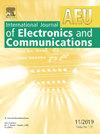A CMOS D-band power combiner with compact size and low insertion loss using packaging-aware design
IF 3.2
3区 计算机科学
Q2 ENGINEERING, ELECTRICAL & ELECTRONIC
Aeu-International Journal of Electronics and Communications
Pub Date : 2025-08-14
DOI:10.1016/j.aeue.2025.156001
引用次数: 0
Abstract
A D-band power combiner is proposed for low-loss interconnection and packaging based on a packaging-aware design methodology, using a 65-nm CMOS technology. The proposed combiner achieves both compact size and low loss by actively incorporating the parasitic effects of RF pads into the circuit design. In particular, the RF pad network, which is indispensable in packaging, is modeled as a combined structure of a transmission line and an effective shunt capacitance, enabling size reduction without performance degradation. The design is based on a careful selection of the characteristic impedance and electrical length of the transmission lines, demonstrating a practical approach for minimizing implementation area while preserving matching performance. In addition, broadband input and output impedance matching is achieved without external matching networks or de-embedding, as the proposed structure inherently compensates for impedance mismatch caused by the RF pads. The proposed power combiner was implemented in a 65-nm CMOS process with 1-poly and 9-metal layers on back-end oxide layers, occupying a compact core area of 0.024 mm2, including the RF pads. Measurement results show a minimum insertion loss of 0.7 dB and a 1-dB bandwidth from 103 to 171 GHz, with more than 20 dB isolation between the input ports from 140 to 190 GHz.
采用封装感知设计的CMOS d波段功率组合器,具有紧凑的尺寸和低插入损耗
基于封装感知设计方法,采用65纳米CMOS技术,提出了一种用于低损耗互连和封装的d波段功率组合器。所提出的组合器通过积极地将射频垫的寄生效应纳入电路设计,实现了紧凑的尺寸和低损耗。特别是封装中不可缺少的射频垫网络,被建模为传输线和有效分流电容的组合结构,可以在不降低性能的情况下减小尺寸。该设计基于对传输线特性阻抗和电气长度的精心选择,展示了在保持匹配性能的同时最小化实施面积的实用方法。此外,宽带输入和输出阻抗匹配是在没有外部匹配网络或去嵌入的情况下实现的,因为所提出的结构固有地补偿了射频垫引起的阻抗失配。该功率组合器采用65纳米CMOS工艺,后端氧化物层上有1层聚层和9层金属层,占据0.024 mm2的紧凑核心面积,包括RF焊盘。测量结果表明,最小插入损耗为0.7 dB,带宽范围为103至171 GHz,输入端口之间的隔离度在140至190 GHz之间超过20 dB。
本文章由计算机程序翻译,如有差异,请以英文原文为准。
求助全文
约1分钟内获得全文
求助全文
来源期刊
CiteScore
6.90
自引率
18.80%
发文量
292
审稿时长
4.9 months
期刊介绍:
AEÜ is an international scientific journal which publishes both original works and invited tutorials. The journal''s scope covers all aspects of theory and design of circuits, systems and devices for electronics, signal processing, and communication, including:
signal and system theory, digital signal processing
network theory and circuit design
information theory, communication theory and techniques, modulation, source and channel coding
switching theory and techniques, communication protocols
optical communications
microwave theory and techniques, radar, sonar
antennas, wave propagation
AEÜ publishes full papers and letters with very short turn around time but a high standard review process. Review cycles are typically finished within twelve weeks by application of modern electronic communication facilities.

 求助内容:
求助内容: 应助结果提醒方式:
应助结果提醒方式:


